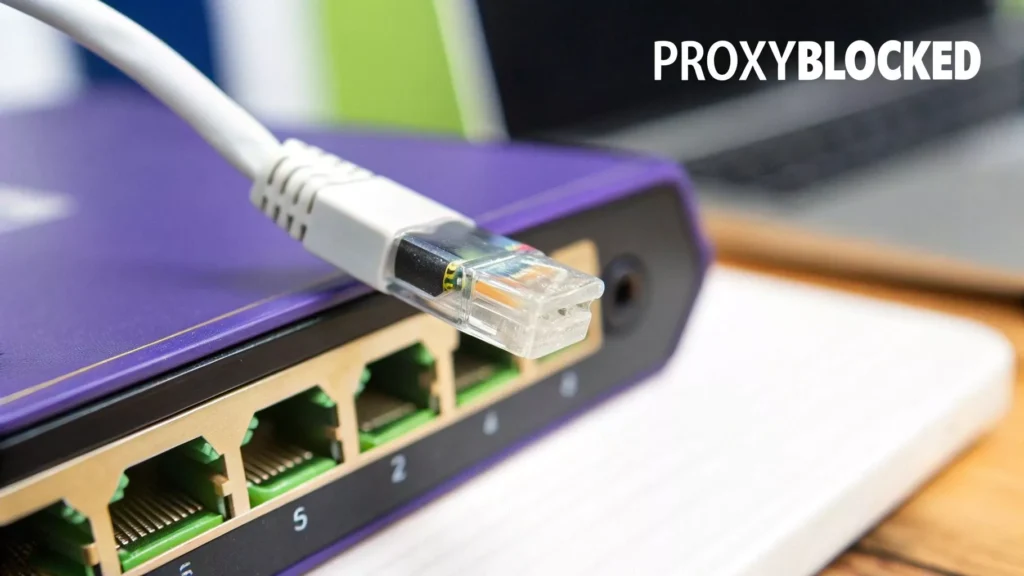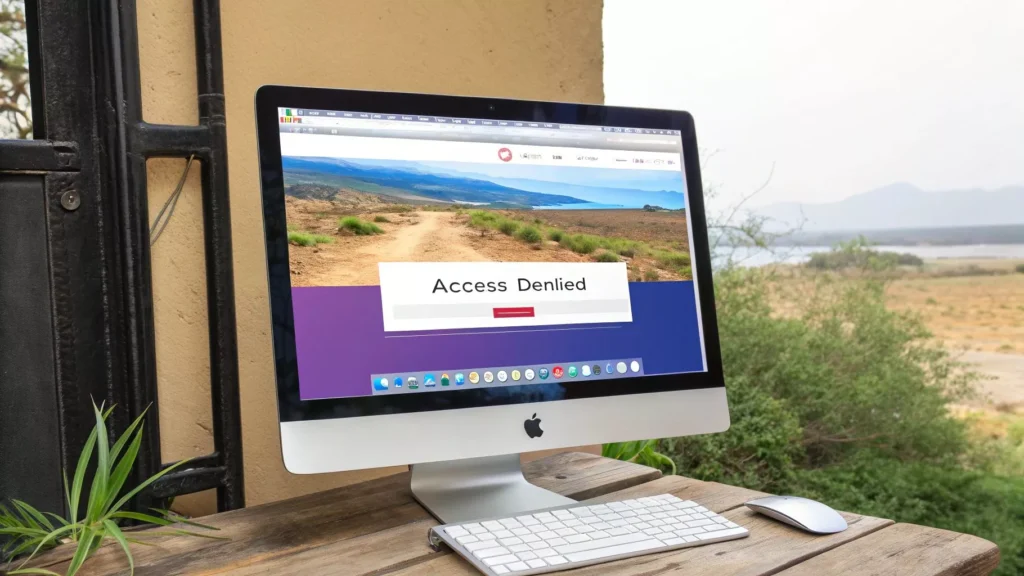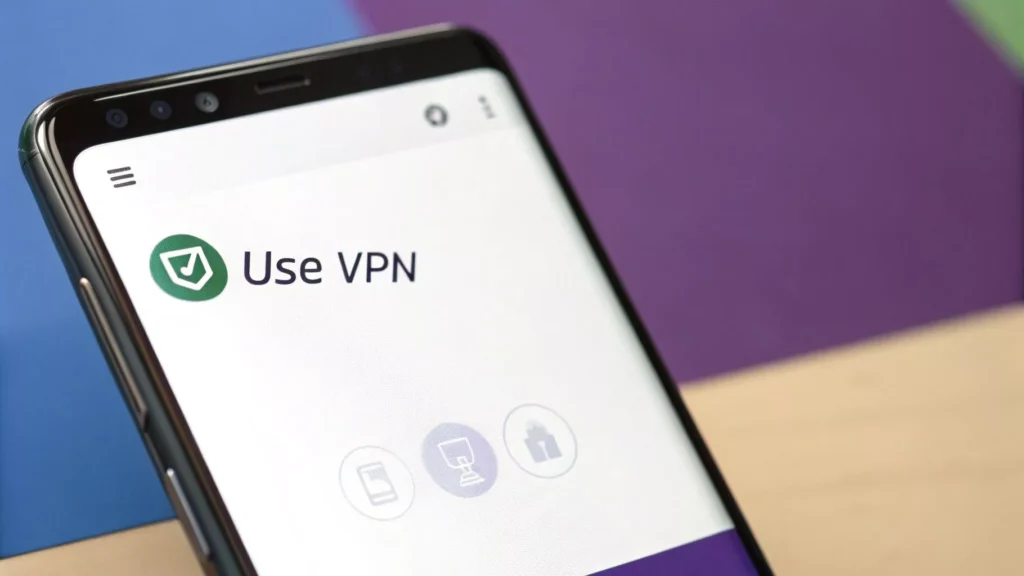When your proxy suddenly stops working, it’s almost always because the target website’s security system has flagged its traffic as suspicious or non-human. This could be something as simple as the IP address appearing on a known blacklist, or it could be a more complex issue where your request patterns triggered an anti-bot system. For example, if you’re trying to scrape 1,000 product pages from an e-commerce site and send all those requests in 30 seconds from one IP, you’ve just told the site’s security you’re a bot, leading to an instant block.
Understanding Why Your Proxy Is Blocked

It’s a frustrating moment for anyone in the data collection space. One minute, your scripts are running perfectly, and the next, you’re completely cut off. The reason your proxy got blocked often goes deeper than just a basic IP ban. Modern websites are armed with layered defense systems designed to protect their data and infrastructure from automated threats.
These systems are getting smarter every day, learning to distinguish between a real person browsing and a script running on a server. For instance, firing off hundreds of requests from a single IP address in under a minute is a dead giveaway. No human can click that fast. This kind of abnormal behavior immediately sets off alarms and leads to a block. A practical example is a script that scrapes flight prices by checking 50 different destinations from the same IP within a minute. A real user would take several minutes, so the system flags this as bot activity.
Distinguishing Block Types
Figuring out the type of block you’re facing is the first real step toward fixing it. Not all blocks are created equal, and they generally fall into two main categories:
- Simple IP Blacklisting: This is the most straightforward type of block. The website keeps a running list of known proxy or datacenter IPs and simply denies access to any request coming from them. It’s a numbers game—if your IP is on their list, you’re out. For example, if you bought a cheap datacenter proxy, its IP range is likely already known and blacklisted by major sites like Amazon or Google.
- Complex Behavioral Blocking: This is where things get tricky. Advanced sites analyze how you access their content. They look at everything from your browser fingerprint and request headers to your cookie management and even the speed and rhythm of your navigation to spot automation. A real-world case is a site noticing your script always visits pages in alphabetical order, something no human user would do, and blocking you based on that predictable pattern.
By 2025, the challenge for proxies is only going to grow as websites double down on these advanced blocking measures. We’re seeing more sophisticated use of blacklists, CAPTCHA challenges, browser fingerprinting, and behavioral analysis to shut down spam and unauthorized data scraping.
To get a quick handle on what might be going on, here’s a look at the most common triggers and your first line of defense for each.
Common Proxy Block Triggers and First Actions
| Block Reason | What It Means | Initial Action |
|---|---|---|
| High Request Rate | You’re sending too many requests too quickly from a single IP. | Actionable Insight: Implement a 2-5 second delay between each request in your script. For example, use time.sleep(random.uniform(2, 5)) in Python. |
| IP Blacklisting | Your IP is on a known list of datacenter or proxy addresses. | Actionable Insight: Immediately switch to a residential proxy from a different subnet. Don’t just get another IP from the same provider; it might be in the same blacklisted block. |
| Suspicious User-Agent | Your request header looks like it came from a bot, not a real browser. | Actionable Insight: Create a list of 10-20 current User-Agents (e.g., from the latest Chrome, Firefox, Safari versions) and have your script randomly select one for each request. |
| Failed CAPTCHA | You’ve been flagged and are now facing an automated challenge. | Actionable Insight: Integrate a service like 2Captcha via their API to solve challenges automatically, or use a proxy provider that has this feature built-in. |
| Geographic Mismatch | Your IP’s location is blocked from accessing the site’s content. | Actionable Insight: If you need to access a UK-only retail site, configure your proxy settings to specifically request an IP address located in London or Manchester. |
Ultimately, diagnosing why your proxy is blocked is the most critical part of the process. Is it the IP itself, or is it the behavior tied to your requests? Answering that question will tell you exactly what your next move should be, shifting you from guesswork to a focused, effective strategy.
Pinpointing the Exact Cause of the Block

When your proxy suddenly gets blocked, the knee-jerk reaction is to just toss it and grab a new IP. But hold on. Before you cycle to a new address, taking a moment to play detective can save you a ton of headaches down the road.
Getting to the root cause isn’t just about fixing the immediate issue; it’s about preventing the same thing from happening to your next IP. The goal is to figure out whether you’re dealing with a simple IP blacklist or a more complex block triggered by your activity.
First things first, run the most basic test: can the proxy even connect to the internet? Point it at a simple, low-security site—think of a basic informational page that has no reason to run anti-bot tools. A good practical test is to try accessing http://httpbin.org/ip through your proxy. If it returns the proxy’s IP, the connection works. If it times out, the problem is with your proxy configuration or the provider itself.
If that initial check passes, you know your proxy works. The problem is that the target site is actively kicking you out. Now, it’s time to look at the clues it’s giving you, which usually come in the form of HTTP error codes.
Decoding Common HTTP Error Codes
Not all blocks are created equal. The server’s response tells a story about why it denied you access, and learning to read these signals is the key to getting back in.
Here are a few of the most common error codes you’ll run into and what they really mean:
- 403 Forbidden: This one is a hard “no.” The server understood your request perfectly but is flat-out refusing to let you in. This often means your IP is on a known blacklist or originates from a geographic region the site doesn’t serve. Actionable Insight: When you get a 403, immediately try the same request with a residential proxy from a valid geo-location. If it goes through, you’ve confirmed an IP or geo-block.
- 429 Too Many Requests: You’ve been too aggressive. This isn’t a permanent ban but more of a temporary timeout. You’ve simply sent too many requests in a short window, and the server is telling you to cool it. The solution? Slow down your request rate. Actionable Insight: Your script should catch this error and automatically “back off” by pausing for 60 seconds before retrying the request with an increased delay.
- 503 Service Unavailable: This code can be a bit tricky. While it sometimes means the target server is actually offline, sophisticated security systems often use it as a smokescreen to temporarily block IPs they suspect of scraping or other automated activity. Actionable Insight: When you hit a 503, retry the request once or twice with a 10-second delay. If it persists, treat it like a 403 and rotate to a completely new IP.
A 403 Forbidden error is your clearest signal that the website’s security has flagged your IP as undesirable. When you see this, it’s a strong hint that a standard datacenter IP won’t cut it, and you likely need to switch to a residential proxy to blend in with regular user traffic.
How to Choose Proxies That Avoid Blocks

If your proxy keeps getting blocked, the type you’re using is almost always the culprit. Not all proxies are created equal, and picking the right one is the single most effective way to prevent blocks before they even happen.
Ultimately, your choice boils down to a balance between cost, speed, and how well the proxy can blend in with regular user traffic. The three main players—datacenter, residential, and mobile proxies—each have their own strengths. Knowing what makes them different is the key to matching your tool to your target’s security. A simple website might not blink at a datacenter proxy, but a sophisticated e-commerce site will sniff it out in a heartbeat.
Datacenter Proxies: Built for Speed and Scale
Datacenter proxies are born in cloud server facilities, which makes them incredibly fast and affordable. They’re perfect for jobs where you need to fire off a massive number of requests to targets that don’t have heavy-duty security.
Practical Use Case: Use datacenter proxies for bulk scraping tasks on sites with low security, like pulling text content from thousands of simple blogs or forums that don’t use Cloudflare or other advanced bot detection. The global proxy market has exploded, with datacenter proxies accounting for roughly 65% of all proxy traffic. Why? Because they can be up to 10 times faster and cost 2 to 5 times less than residential options, as confirmed by industry reports on data center proxies in 2025.
Residential Proxies: Your Secret to Blending In
Residential proxies use IP addresses assigned by Internet Service Providers (ISPs) to real homeowners. This makes your traffic look like it’s coming from an actual person’s laptop or phone, giving you a high level of authenticity that helps you fly under the radar.
- E-commerce Sites: For scraping product prices from sites like Amazon or Shopify with their tough anti-bot measures, residential IPs are non-negotiable.
- Social Media Management: If you’re managing multiple accounts, these proxies make your activity look like it’s coming from different, completely legitimate users. Practical Use Case: When managing five Instagram accounts, assign each one a different residential proxy to make it appear as if five different people are accessing the platform from their homes.
A residential proxy is your best defense against websites that use sophisticated behavioral analysis. Since the IP is tied to a real device, it’s nearly impossible for a target site to distinguish it from a genuine visitor.
Geo-Targeting for Pinpoint Accuracy
Finally, don’t forget about location. Geo-targeting lets you pick an IP address from a specific country, city, or even ISP. This is crucial for getting around content restrictions tied to certain regions.
For instance, if you need to check ad placements that only show up for users in Germany, you absolutely have to use a proxy with a German IP. This kind of precision bypasses geographic blocks and guarantees you see the content exactly as a local user would. Actionable Insight: When setting up your proxy request, specify the country code, e.g., country-DE in your proxy provider’s API call, to ensure you get a German IP for this specific task. For tasks that demand this level of trust and location accuracy, checking out options like IPFLY’s residential proxies is the logical next step.
Implementing Smart Proxy Rotation Strategies

If your proxy keeps getting blocked, there’s a good chance a static IP is the culprit. Using the same IP address for too long is like waving a giant red flag at a website’s security system. The fix isn’t just about using proxies—it’s about using them intelligently. That means rotating your IPs to mimic natural user behavior and fly under the radar.
But this isn’t about just randomly swapping out addresses. A smart rotation strategy is tailored to the job at hand. The way you’d handle a massive data scrape is completely different from how you’d manage a few social media accounts, and your approach needs to reflect that.
Sticky Sessions Versus High-Frequency Rotation
The first step is understanding the two main rotation models. Each has a specific purpose, and picking the wrong one is a fast track to getting blocked.
- Sticky Sessions: This is where you hold onto the same IP address for a set period, usually anywhere from 5 to 30 minutes. It’s perfect for tasks that need a consistent session, like working through a multi-step checkout process or managing an online account. Practical Example: When adding an item to a shopping cart and proceeding to checkout, use a sticky session to ensure the website sees the entire journey coming from the same user, avoiding security triggers.
- High-Frequency Rotation: This is the exact opposite. You change your IP address with every single request you make, or at the very least, after a small handful of them. This is the go-to method for large-scale data gathering where you’re hitting thousands of pages. Practical Example: When scraping 10,000 product pages for pricing data, configure your proxy manager to assign a new IP for each page request to avoid tripping rate limits.
The golden rule of smart rotation is to match your proxy’s behavior to what a real user would do. High-frequency rotation for account management is a recipe for failure, just as a sticky session for a massive web scrape is inefficient and asking for trouble.
To help you decide, here’s a quick look at how these strategies stack up.
Comparing Proxy Rotation Strategies
| Rotation Strategy | Best For | Pros | Cons |
|---|---|---|---|
| Sticky Sessions | Account management, e-commerce checkouts, form submissions, social media tasks. | Maintains session integrity, mimics real user behavior for stateful tasks. | Less anonymous over time, easier to block if behavior becomes suspicious. |
| High-Frequency Rotation | Large-scale web scraping, price aggregation, SERP data collection. | Maximizes anonymity, distributes requests to avoid rate limits and single-IP blocks. | Can break session-dependent websites, looks unnatural for non-scraping tasks. |
Choosing the right approach from the start will save you a world of headaches and keep your projects running smoothly.
Automating Failover for Uninterrupted Operations
Even with a perfect rotation strategy, some of your proxies are going to fail. It’s just a fact of life. They’ll get blocked, time out, or run into errors. Manually finding and replacing these bad IPs is a time-consuming nightmare that can grind your whole operation to a halt.
This is where automated failover logic comes in.
Actionable Insight: Implement a try-except block in your code. The try block makes the request. The except block catches connection errors or specific HTTP error codes (like 403, 429). When an exception is caught, your code should immediately call your proxy manager for a new IP and retry the request.
This creates a self-healing process that keeps your project moving forward without you having to constantly intervene. For anyone looking to build a robust system, our guide on IPFLY integration options offers practical advice on setting this up.
This proactive approach is what separates a fragile, amateur setup from a resilient, scalable one. It ensures your data collection remains consistent and prevents a few bad apples from spoiling the entire batch.
Advanced Tactics for Bypassing Tough Blocks
So, you’re rotating IPs, but you’re still getting blocked. What gives?
When the standard tricks aren’t cutting it, it’s time to realize that sophisticated anti-proxy systems are looking way beyond your IP address. They’re profiling your entire digital identity, and if every request you send has the same generic browser fingerprint, you might as well be waving a giant red flag. Just swapping IPs isn’t enough.
The real goal is to make every single one of your requests look like it came from a completely normal, everyday user. That means you have to start sweating the small stuff—like your HTTP headers. The user-agent header, for instance, is a dead giveaway. It tells the website exactly what browser and OS you’re supposedly using. If that user-agent is outdated or doesn’t match your other signals, you’re getting blocked. Simple as that.
Building a Convincing Digital Identity
To fly under the radar, you need to think bigger than just your IP and user-agent. Modern security systems are smart; they track cookies and session data to piece together a history of your activity. This is where you need to get crafty.
- Header Consistency: Make sure all your headers actually make sense together. If your user-agent screams “Chrome on Windows,” but your other headers like
Accept-LanguageorAccept-Encodinglook like they came from Safari on a Mac, you’ve already lost the game. It’s an easy catch. Actionable Insight: Use a library likefake_useragentin Python to generate complete, consistent header sets, not just the user-agent string. - Cookie Management: This is non-negotiable for any task that needs a consistent session. If a website gives you a cookie, your very next request better have that cookie attached. Forgetting to do so is a classic bot move and an instant giveaway that you’re not a legitimate user. Actionable Insight: Use a session object (e.g.,
requests.Session()in Python) that automatically handles cookies for you across multiple requests, ensuring session continuity.
Look, the only way to beat these systems is to be holistic. Don’t just change your IP; change your entire digital persona with every session. That means rotating user-agents, properly managing your cookies, and even randomizing your request patterns. You have to build a believable footprint from the ground up to stay undetected.
Common Questions About Blocked Proxies
We get a lot of questions about why proxies get blocked. Here are some straight answers to the most common ones.
Can a Website Actually Tell I’m Using a Proxy?
Absolutely, and it’s often easier than you think—especially if you’re using a datacenter proxy. Most major websites maintain and cross-reference databases of known commercial IP addresses.
Beyond that, their systems are smart. They analyze behavior. If they see an IP making an unusual number of requests in a short burst, that’s a classic sign of automation, and it’s an easy way to get your proxy flagged and blocked. For example, a website can see that your IP address belongs to an Amazon Web Services (AWS) data center, which is a clear giveaway that it’s not a regular home user.
How Often Should I Be Rotating My IPs?
This really comes down to what you’re trying to do.
For big data scraping jobs, you’ll want to rotate your IP with every single request. It’s the best way to fly under the radar and avoid hitting those pesky rate limits that can shut down your whole operation. A practical example is scraping Google search results, where each query should ideally come from a fresh IP to avoid CAPTCHAs.
But if you’re managing something like a social media or e-commerce account, a different approach is needed. You should use a “sticky” IP session that lasts for at least 10-15 minutes. This keeps your session consistent and helps you avoid triggering fraud detection systems that look for rapid IP changes.
The demand for reliable proxy solutions is exploding, particularly in e-commerce and cybersecurity. The market was valued at around $5 billion in 2023 and is on track to more than triple, hitting a projected $15 billion by 2033. This growth highlights just how critical high-quality proxies have become. You can find more details about this market expansion on datainsightsmarket.com.
I’m Using a Residential Proxy, So Why Am I Still Getting Blocked?
While residential IPs are a massive step up and much harder to spot, they aren’t a magic bullet. You can still get blocked if your activity looks unnatural or robotic.
Think about it from the website’s perspective. If you’re sending requests faster than any human could, using mismatched browser headers, or failing to handle cookies correctly, you’re going to get flagged as a bot. It doesn’t matter how good your IP is at that point—your behavior gave you away. A clear example is using a residential proxy but forgetting to include a realistic Accept-Language header. This small oversight can be enough for a sophisticated system to flag your request as automated.
Ready to stop worrying about blocked proxies? IPFLY gives you access to a massive, clean pool of over 90 million residential IPs built to keep your projects online and running smoothly. Get started with IPFLY’s reliable proxies today!


